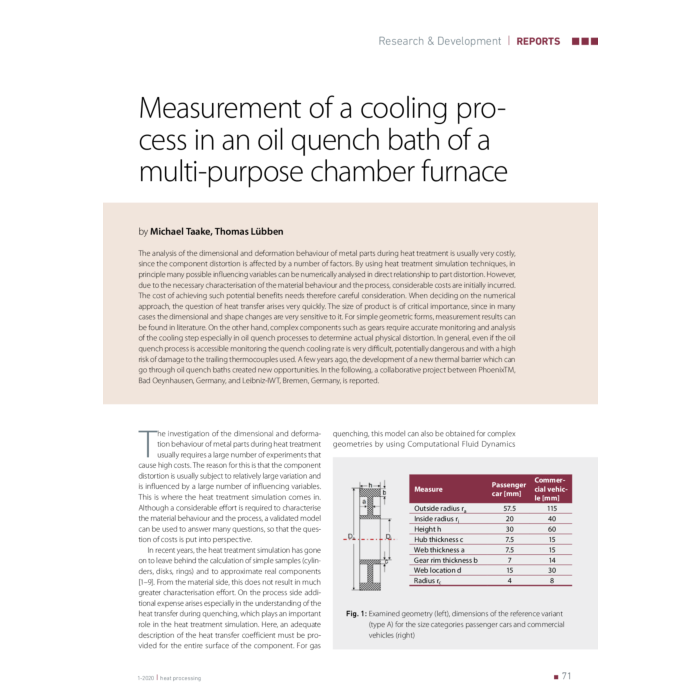Measurement of a cooling process in an oil quench bath of a multi-purpose chamber furnace
4,90 €
Auf Lager
Artikelnummer
00541_2020_01_05
The analysis of the dimensional and deformation behaviour of metal parts during heat treatment is usually very costly, since the component distortion is affected by a number of factors. By using heat treatment simulation techniques, in principle many possible influencing variables can be numerically analysed in direct relationship to part distortion. However, due to the necessary characterisation of the material behaviour and the process, considerable costs are initially incurred. The cost of achieving such potential benefits needs therefore careful consideration. When deciding on the numerical approach, the question of heat transfer arises very quickly. The size of product is of critical importance, since in many cases the dimensional and shape changes are very sensitive to it. For simple geometric forms, measurement results can be found in literature. On the other hand, complex components such as gears require accurate monitoring and analysis of the cooling step especially in oil quench processes to determine actual physical distortion. In general, even if the oil quench process is accessible monitoring the quench cooling rate is very difficult, potentially dangerous and with a high risk of damage to the trailing thermocouples used. A few years ago, the development of a new thermal barrier which can go through oil quench baths created new opportunities. In the following, a collaborative project between PhoenixTM, Bad Oeynhausen, Germany, and Leibniz-IWT, Bremen, Germany, is reported.
| Autoren | Michael Taake, Thomas Lübben |
|---|---|
| Erscheinungsdatum | 11.03.2020 |
| Format | |
| Verlag | Vulkan-Verlag GmbH |
| Sprache | English |
| Titel | Measurement of a cooling process in an oil quench bath of a multi-purpose chamber furnace |
| Beschreibung | The analysis of the dimensional and deformation behaviour of metal parts during heat treatment is usually very costly, since the component distortion is affected by a number of factors. By using heat treatment simulation techniques, in principle many possible influencing variables can be numerically analysed in direct relationship to part distortion. However, due to the necessary characterisation of the material behaviour and the process, considerable costs are initially incurred. The cost of achieving such potential benefits needs therefore careful consideration. When deciding on the numerical approach, the question of heat transfer arises very quickly. The size of product is of critical importance, since in many cases the dimensional and shape changes are very sensitive to it. For simple geometric forms, measurement results can be found in literature. On the other hand, complex components such as gears require accurate monitoring and analysis of the cooling step especially in oil quench processes to determine actual physical distortion. In general, even if the oil quench process is accessible monitoring the quench cooling rate is very difficult, potentially dangerous and with a high risk of damage to the trailing thermocouples used. A few years ago, the development of a new thermal barrier which can go through oil quench baths created new opportunities. In the following, a collaborative project between PhoenixTM, Bad Oeynhausen, Germany, and Leibniz-IWT, Bremen, Germany, is reported. |
Eigene Bewertung schreiben


